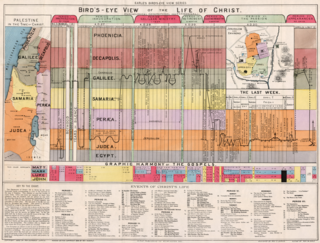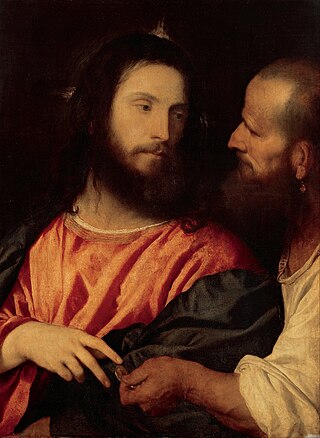
The denarius was the standard Roman silver coin from its introduction in the Second Punic War c. 211 BC to the reign of Gordian III, when it was gradually replaced by the antoninianus. It continued to be minted in very small quantities, likely for ceremonial purposes, until and through the Tetrarchy (293–313).

Tiberius Julius Caesar Augustus was a Roman emperor. He reigned from AD 14 until 37, succeeding his stepfather, the first Roman emperor Augustus. Tiberius was born in Rome in 42 BC. His father was the politician Tiberius Claudius Nero and his mother was Livia Drusilla, who would eventually divorce his father, and marry the future-emperor Augustus in 38 BC. Following the untimely deaths of Augustus' two grandsons and adopted heirs, Gaius and Lucius Caesar, Tiberius was designated Augustus' successor. Prior to this, Tiberius had proved himself an able diplomat, and one of the most successful Roman generals: his conquests of Pannonia, Dalmatia, Raetia, and (temporarily) parts of Germania laid the foundations for the empire's northern frontier.

In ancient Roman religion, Roma was a female deity who personified the city of Rome and more broadly, the Roman state. She was created and promoted to represent and propagate certain of Rome's ideas about itself, and to justify its rule. She was portrayed on coins, sculptures, architectural designs, and at official games and festivals. Images of Roma had elements in common with other goddesses, such as Rome's Minerva, her Greek equivalent Athena and various manifestations of Greek Tyche, who protected Greek city-states; among these, Roma stands dominant, over piled weapons that represent her conquests, and promising protection to the obedient. Her "Amazonian" iconography shows her "manly virtue" (virtus) as fierce mother of a warrior race, augmenting rather than replacing local goddesses. On some coinage of the Roman Imperial era, she is shown as a serene advisor, partner and protector of ruling emperors. In Rome, the Emperor Hadrian built and dedicated a gigantic temple to her as Roma Aeterna, and to Venus Felix,, emphasising the sacred, universal and eternal nature of the empire.

The sestertius, or sesterce, was an ancient Roman coin. During the Roman Republic it was a small, silver coin issued only on rare occasions. During the Roman Empire it was a large brass coin.

Roman currency for most of Roman history consisted of gold, silver, bronze, orichalcum and copper coinage. From its introduction during the Republic, in the third century BC, through Imperial times, Roman currency saw many changes in form, denomination, and composition. A persistent feature was the inflationary debasement and replacement of coins over the centuries. Notable examples of this followed the reforms of Diocletian. This trend continued with Byzantine currency.

The aureus was a gold coin of ancient Rome originally valued at 25 pure silver denarii. The aureus was regularly issued from the 1st century BC to the beginning of the 4th century AD, when it was replaced by the solidus. The aureus was about the same size as the denarius, but heavier due to the higher density of gold.
Roman Republican currency is the coinage struck by the various magistrates of the Roman Republic, to be used as legal tender. In modern times, the abbreviation RRC, "Roman Republican Coinage" originally the name of a reference work on the topic by Michael H. Crawford, has come to be used as an identifying tag for coins assigned a number in that work, such as RRC 367.

Mark 12 is the twelfth chapter of the Gospel of Mark in the New Testament of the Christian Bible. It continues Jesus' teaching in the Temple in Jerusalem, and contains the parable of the Wicked Husbandmen, Jesus' argument with the Pharisees and Herodians over paying taxes to Caesar, and the debate with the Sadducees about the nature of people who will be resurrected at the end of time. It also contains Jesus' greatest commandment, his discussion of the messiah's relationship to King David, condemnation of the teachers of the law, and his praise of a poor widow's offering.

A chronology of Jesus aims to establish a timeline for the events of the life of Jesus. Scholars have correlated Jewish and Greco-Roman documents and astronomical calendars with the New Testament accounts to estimate dates for the major events in Jesus's life.

The New Testament narrative of the life of Jesus refers to a number of locations in the Holy Land and a Flight into Egypt. In these accounts the principal locations for the ministry of Jesus were Galilee and Judea, with activities also taking place in surrounding areas such as Perea and Samaria.

Matthew 22 is the twenty-second chapter in the Gospel of Matthew in the New Testament section of the Christian Bible. Jesus continues his final ministry in Jerusalem before his Passion. Teaching in the Temple, Jesus enters into debate successively with the Pharisees, allied with the Herodians, the Sadducees, and a lawyer, ultimately silencing them all.

"Render unto Caesar" is the beginning of a phrase attributed to Jesus in the synoptic gospels, which reads in full, "Render unto Caesar the things that are Caesar's, and unto God the things that are God's".

Caesar Augustus, also known as Octavian, was the first and among the most important of the Roman Emperors. As such, he has frequently been depicted in literature and art since ancient times.

The Temple of Divus Augustus was a major temple originally built to commemorate the deified first Roman emperor, Augustus. It was built between the Palatine and Capitoline Hills, behind the Basilica Julia, on the site of the house that Augustus had inhabited before he entered public life in the mid-1st century BC. It is known from Roman coinage that the temple was originally built to an Ionic hexastyle design. However, its size, physical proportions and exact site are unknown. Provincial temples of Augustus, such as the much smaller Temple of Augustus in Pula, now in Croatia, had already been constructed during his lifetime. Probably because of popular resistance to the notion, he was not officially deified in Rome until after his death, when a temple at Nola in Campania, where he died, seems to have been begun. Subsequently, temples were dedicated to him all over the Roman Empire.

The Tribute Money is a fresco by the Italian Early Renaissance painter Masaccio, located in the Brancacci Chapel of the basilica of Santa Maria del Carmine, Florence. Painted in the 1420s, it is widely considered among Masaccio's best work, and a vital part of the development of Renaissance art.

The coin in the fish's mouth is one of the miracles of Jesus, recounted in the Gospel of Matthew 17:24–27.

The Tribute Money is a panel painting in oils of 1516 by the Italian late Renaissance artist Titian, now in the Gemäldegalerie Alte Meister in Dresden, Germany. It depicts Christ and a Pharisee at the moment in the Gospels when Christ is shown a coin and says "Render unto Caesar the things that are Caesar's, and unto God the things that are God's". It is signed "Ticianus F.[ecit]", painted on the trim of the left side of the Pharisee's collar.
A number of coins are mentioned in the Bible, and they have proved very popular among coin collectors.

Publius Sulpicius Quirinius, also translated as Cyrenius, was a Roman aristocrat. After the banishment of the ethnarch Herod Archelaus from the tetrarchy of Judea in AD 6, Quirinius was appointed legate governor of Syria, to which the province of Judaea had been added for the purpose of a census.

Revelation 6 is the sixth chapter of the Book of Revelation or the Apocalypse of John in the New Testament of the Christian Bible. The book is traditionally attributed to John the Apostle, but the precise identity of the author remains a point of academic debate. This chapter describes the opening of the first six of the seven seals. The opening of the seventh seal is recorded in chapter 8. Four horses and their riders, the Four Horsemen of the Apocalypse, emerge as the first four seals are opened.


















